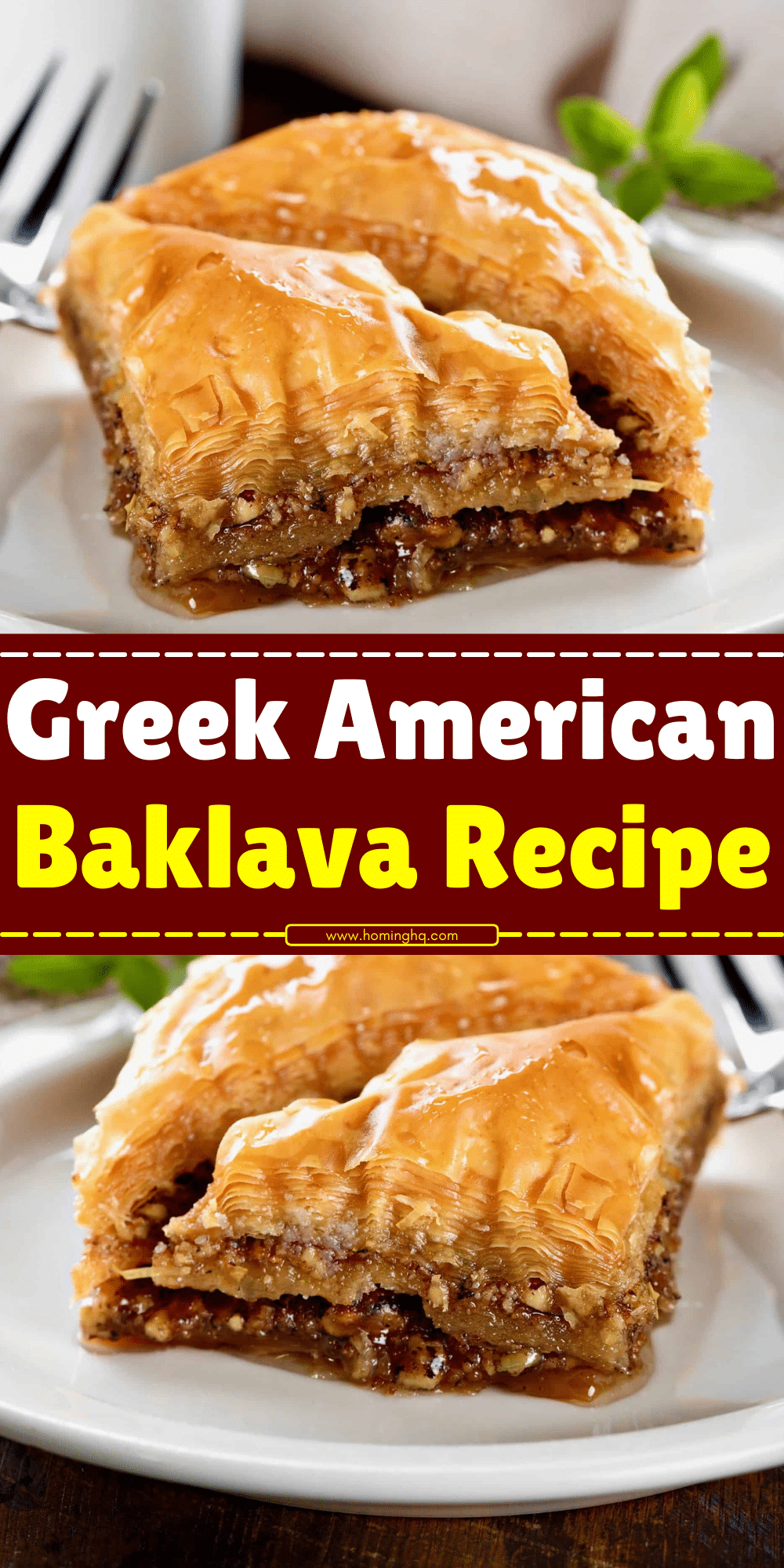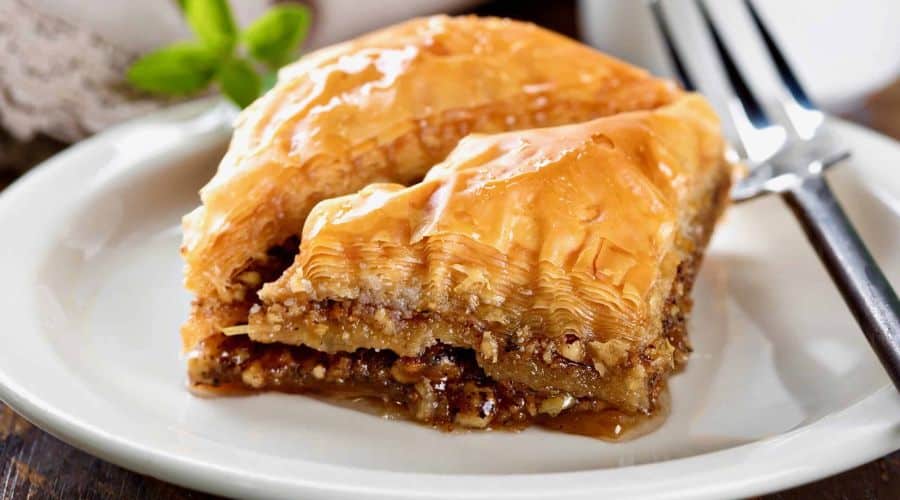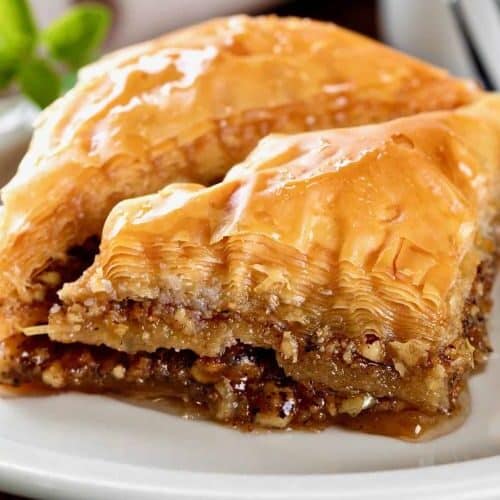Baklava, the delicate pastry that perfectly balances sweetness, crunch, and rich flavors, has long been adored around the world.
While its roots trace back to the ancient Ottoman Empire, today’s modern versions of baklava have evolved across many cultures, including Greek and American.
This unique fusion, the Greek-American Baklava, combines traditional Greek ingredients and techniques with a more accessible American twist. Whether you’re new to baklava or a seasoned fan, this version offers the best of both worlds—a deliciously crisp, syrup-drenched treat with a slightly milder flavor profile that is perfect for any occasion.
In this recipe, we’ll walk you through making your own Greek-American Baklava at home. Get ready to create a dessert that brings together history, flavor, and a touch of American ingenuity!

The History of Baklava: A Sweet Legacy
Origins of Baklava in the Mediterranean
Baklava has been enjoyed for centuries across the Mediterranean and the Middle East. While its exact origin is debated, many believe the dessert has its roots in the ancient empires that flourished around the Mediterranean Sea. The dessert’s distinct layers of filo dough, nuts, and sweet syrup were passed down through generations, adapting to regional tastes and available ingredients.
Evolution of Greek Baklava
Greek baklava is often recognized by its use of honey, walnuts, and a delicate sprinkling of cinnamon. Greek versions are known for their balanced sweetness and reliance on local ingredients that have stood the test of time. As the pastry spread across the region, each country introduced its own nuances.
How the American Version Came to Be
As baklava made its way to America through immigrants from Greece and the broader Mediterranean, the recipe was adapted to suit local preferences. The American version of baklava often includes a more diverse mix of nuts—walnuts, pistachios, and almonds—and sometimes utilizes butter in place of traditional ghee or oils. The syrup, too, is often sweeter, with a richer honey base, thanks to the American palate’s love for indulgent sweets.
What Makes Greek-American Baklava Different?
Greek-American Baklava stands out due to its fusion of traditional Greek and American elements. While both versions feature crispy filo dough and a nutty filling, the key differences lie in the type of nuts used, the richness of the syrup, and sometimes even the addition of spices like cinnamon or clove.
Nuts and Filling
In traditional Greek baklava, walnuts are often the star nut, providing a satisfying crunch and earthy flavor. However, Greek-American baklava may incorporate a mix of pistachios, almonds, and walnuts, offering a broader variety of textures and flavors. The nut filling is typically more generously layered in the American version, making it a bit heartier.
Syrup and Sweetness
One of the most notable differences is in the syrup. Greek baklava typically uses a more modest syrup made from honey, sugar, and water, allowing the nut flavor to shine. In contrast, Greek-American Baklava tends to have a thicker, sweeter syrup, with a higher ratio of sugar and honey to create a more indulgent treat.
Buttery Layers
The American version of baklava also tends to use more butter in the layers, contributing to a richer, more decadent flavor. The extra butter helps achieve a golden, crispy texture, which is the hallmark of a perfect baklava.
Ingredients for Greek-American Baklava
To make this delightful treat, you’ll need a selection of simple yet essential ingredients. Each one plays a role in bringing the flavors and textures of Greek-American Baklava to life.
For the Nut Filling:
- Nuts: A mix of walnuts, pistachios, and almonds (about 2-3 cups in total)
- Cinnamon: Adds a warm, fragrant touch to the nut mixture
- Sugar: To enhance the sweetness of the nuts without overpowering them
For the Filo Dough Layers:
- Filo Dough: Available at most grocery stores in the frozen section
- Butter: To brush between the filo layers, ensuring a golden, crisp texture
For the Syrup:
- Honey: A key ingredient that imparts the signature sweetness
- Sugar: Adds structure and thickness to the syrup
- Water: Helps dissolve the sugar and balance the sweetness
- Lemon Juice: A touch of acidity to cut through the sweetness and enhance the syrup’s flavor
Step-by-Step Instructions: Making Greek-American Baklava

Making Greek-American Baklava may seem intimidating at first, but with a little patience, you can create this show-stopping dessert right at home. Follow these steps for the perfect balance of crispy layers and syrup-soaked sweetness.
Preparing the Nut Filling
Start by finely chopping your nuts. You want a consistent, but slightly coarse texture—nothing too fine. Place them in a large mixing bowl and add the cinnamon and sugar. Mix everything together thoroughly, ensuring the sugar and cinnamon coat the nuts evenly. Set this filling aside while you prepare the rest of the baklava.
Assembling the Baklava
Layering the Filo Dough
Preheat your oven to 350°F (175°C). Unwrap the filo dough and place it on a clean, dry surface. Cover it with a damp cloth to prevent it from drying out while you work.
Begin by buttering the bottom of your baking dish (preferably a 9×13-inch dish). Place the first sheet of filo dough in the dish, brushing it lightly with melted butter. Continue layering the filo dough, brushing each layer with butter. You’ll need about 8-10 layers to form the base.
Once you’ve created your bottom layer, sprinkle a thin, even layer of the nut filling over the filo dough. Add another 4-6 layers of buttered filo dough, then add more nut filling. Repeat this process until you run out of filo dough and filling, finishing with a final 8-10 layers of filo dough on top.
Baking the Baklava
Use a sharp knife to cut the baklava into squares or diamonds. This is important because it allows the syrup to soak in more effectively later. Place the baklava in the oven and bake for about 45-50 minutes, or until it’s golden brown and crispy on top.
Making the Syrup
While the baklava is baking, combine the honey, sugar, water, and lemon juice in a saucepan. Bring it to a boil, then reduce the heat and let it simmer for 10-15 minutes. The syrup should thicken slightly but still be pourable.
Finishing Touches: Pouring the Syrup
Once the baklava is done, remove it from the oven and let it cool for about 10 minutes. Then, carefully pour the hot syrup evenly over the warm baklava. Allow the baklava to sit for a few hours or overnight so it can absorb the syrup and become even more flavorful.
How to Assemble and Pour the Syrup Over Baklava
Once your baklava is baked to golden perfection, it’s time to add the signature syrup that will give it its irresistible sweetness and sticky texture. This step is crucial for creating that delightful contrast between the crispy layers and the syrup-soaked filling.
Assembling the Baklava Before Syrup
Before pouring the syrup, you’ll need to ensure the baklava has cooled slightly—just 10-15 minutes after baking will suffice. Using a sharp knife, cut the baklava into squares or diamond shapes (cut all the way through the layers). This will allow the syrup to seep into every layer and prevent it from being absorbed unevenly.
Pouring the Syrup
Once the baklava is prepped, pour the warm syrup evenly over the cut pieces. It’s important to pour the syrup slowly, ensuring that every layer gets soaked without the syrup pooling in one area. As the syrup is absorbed, the baklava will soften slightly but retain its signature crispness on top. Let the baklava sit for a few hours or, ideally, overnight, for the flavors to meld and the syrup to fully soak in.
Variations of Greek-American Baklava
While the classic Greek-American Baklava recipe is a hit on its own, there are plenty of ways to make it your own with creative variations. Here are some ideas to experiment with:
Different Nut Combinations
While traditional baklava often uses a mix of walnuts and pistachios, you can customize the nut filling to suit your taste. Try using hazelnuts, pecans, or almonds for different flavor profiles. You can also experiment with a combination of two or more nuts for a unique twist.
Spices and Flavors
If you want to add extra flavor depth to your baklava, consider adding spices like ground cardamom, nutmeg, or even a hint of vanilla extract to the nut mixture. These additions can lend a slightly exotic flavor to your baklava, making it even more special.
Nut-Free Baklava
For those with nut allergies, you can try a nut-free version of baklava. Instead of the typical nut mixture, consider using seeds like sunflower seeds or pumpkin seeds, or even shredded coconut for a different texture.
Vegan Baklava
Making a vegan version of Greek-American Baklava is easy to do. Simply substitute the butter with plant-based alternatives such as coconut oil or vegan margarine. Ensure that the filo dough you use is free from dairy and egg products, and you’ll have a delicious vegan treat.
Gluten-Free Baklava
If you’re following a gluten-free diet, you can find gluten-free filo dough at many specialty grocery stores. With this substitution, the baklava will be just as crispy and indulgent without the gluten.
Frequently Asked Questions (FAQs)
1. Can I make baklava ahead of time?
Yes! Baklava actually tastes better when it sits for a few hours or even overnight. The syrup has time to fully soak into the layers, resulting in a richer flavor and softer texture. You can store it at room temperature for up to 3-4 days, or refrigerate it for longer storage.
2. Can I freeze baklava?
Absolutely. If you have leftovers or want to prepare it in advance, baklava freezes well. After it’s fully cooled, wrap it tightly in plastic wrap or aluminum foil and place it in an airtight container or freezer bag. To enjoy, simply thaw it at room temperature or warm it slightly in the oven.
3. Why is my baklava soggy?
Sogginess can occur if the syrup is poured on while the baklava is too hot or the syrup is too thin. Make sure to let both the baklava and the syrup cool slightly before pouring. Also, be sure to allow enough time for the syrup to fully soak into the baklava, but don’t let it sit too long in the syrup or it can lose its crispness.
4. Can I make baklava without filo dough?
Filo dough is a key ingredient in baklava and contributes to its signature crispy texture. Unfortunately, there isn’t a suitable substitute that will provide the same flaky layers. If you’re looking for a similar dessert, you could try making a pastry using puff pastry, but it will not have the same texture as traditional baklava.
5. How can I store baklava for freshness?
Store baklava at room temperature in an airtight container. It will stay fresh for up to 3-4 days. For longer storage, keep it in the refrigerator for up to a week or freeze it for a few months.
Conclusion
Greek-American Baklava is more than just a dessert; it’s a celebration of culture, flavor, and tradition. The combination of flaky filo dough, crunchy nuts, and sweet syrup creates a treat that is as satisfying to make as it is to eat. Whether you’re preparing it for a special occasion or as a sweet snack, this indulgent dessert is sure to impress.
So go ahead, follow the recipe, and share this delicious slice of Greek-American fusion with your friends and family. Your taste buds will thank you, and you’ll have a new favorite dessert to enjoy for years to come.

Greek-American Baklava
Equipment
- 1 9×13-inch baking dish
- 1 Sharp knife (for cutting baklava)
- 1 Pastry brush
- 1 Small saucepan (for syrup)
- 1 Mixing bowl (for nut filling)
- 1 Large baking sheet (optional, for pre-baking filo dough)
- 1 Basting brush (for buttering filo dough)
Ingredients
For the Nut Filling:
- 2 cups Walnuts chopped
- 1 cup Pistachios chopped
- 1 cup Almonds chopped
- 1 tsp Ground cinnamon
- 1/2 cup Granulated sugar
For the Filo Dough Layers:
- 1 package Filo dough approximately 20-24 sheets
- 1 cup Butter melted (plus extra for greasing)
For the Syrup:
- 1 cup Honey
- 1 cup Granulated sugar
- 1/2 cup Water
- 1 tsp Fresh lemon juice
Instructions
- Preheat the oven to 350°F (175°C).
- Prepare the nut filling: In a bowl, combine the chopped walnuts, pistachios, almonds, cinnamon, and sugar. Set aside.
- Layer the filo dough: Brush the bottom of a 9×13-inch baking dish with melted butter. Place the first sheet of filo dough into the dish and brush it with butter. Continue layering and buttering sheets until you have about 8-10 sheets layered.
- Add the nut filling: Evenly sprinkle a thin layer of the nut mixture over the filo dough. Continue layering 4-6 more buttered filo sheets, then add another layer of nuts. Repeat until the ingredients are used up, finishing with 8-10 layers of filo dough on top.
- Cut the baklava: Use a sharp knife to cut the baklava into squares or diamond shapes.
- Bake the baklava: Place the baklava in the oven and bake for 45-50 minutes, or until golden brown and crispy.
- Make the syrup: While the baklava is baking, combine the honey, sugar, water, and lemon juice in a small saucepan. Bring to a boil, then lower the heat and simmer for about 10-15 minutes, until the syrup thickens slightly.
- Pour the syrup: Once the baklava is done baking, remove it from the oven and allow it to cool for 10-15 minutes. Pour the warm syrup evenly over the baklava, making sure it soaks into every layer.
- Rest and serve: Allow the baklava to cool completely and rest for several hours or overnight to fully absorb the syrup. Cut into squares or diamonds and serve.
Notes
- Nut variety: Feel free to adjust the nut types based on your preferences or availability. Walnuts, pistachios, and almonds are the traditional choices, but you can experiment with others like hazelnuts or pecans.
- Filo dough handling: Be sure to keep your filo dough covered with a damp towel while you work to prevent it from drying out.
- Storage: Store baklava at room temperature in an airtight container for up to 3-4 days. You can refrigerate it for longer storage, or freeze it for up to 2-3 months.
- Vegan & gluten-free options: To make vegan baklava, substitute the butter with plant-based options, and for a gluten-free version, use gluten-free filo dough.

